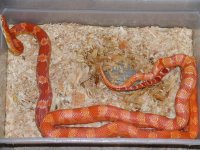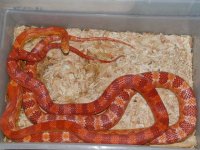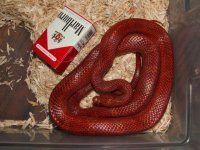ecreipeoj
Striped Topaz SK SG Free
paulh
You seem to know a great deal about genetics and the co-dominant gene. Please write up something that is better than what I posted and I will be happy to delete it. Leave out all the Gecko stuff.
I have a question about this test for Darrin. Which Hets for Bloods are we considering. Depending on whether Bloods are recessive or co-dominant, the offspring from a Blood may not be Het Blood at all. When we consider Bloods as co-dominant, are we considering them to all be Homo Blood and not Het Bloods. Are we saying that a Homo Blood and Het Blood will look different. If this is the case, why? They should look very similar. Other co-dominant genes in snakes, cause the offspring in Homo or Het form to look almost a like and easily detectable. A Het Salmon and Normal Boa are as different as night and day. A Homo Salmon and Het Salmon are so close that you can not tell without test breeding.
If Bloods are recessive all offspring will be Het Blood. If Bloods are co-dominant, half of the offspring will be normal and not be Het Blood at all, unless we are trying to say that all Bloods are Homo Blood and then all offspring would be het Bloods and none of them would look normal at all. This may explain why some offspring that are considered hets have the checkered belly. They are not hets at all. This is if the Blood gene is co-dominant.
If someone assumes that the Blood gene is recessive and that all offspring are Het Bloods, but the gene is co-dominant, this pattern recognition won‘t work. When we save these normals from the Blood X normal breeding, assuming they are hets (recessive) and we breed them back to a Blood, the resulting offspring will be half Bloods as if we were breeding a Blood X Het Blood(recessive), but a Blood (co-dominant) X Normal would produce half Bloods as well.
This is the same mistake people make with my Spotted Donkeys. They save a solid from a Spotted, assuming that it is recessive, and breed it to a Spotted. When they get a Spotted foal, they think it is because the solid was het(recessive) spotted when in fact that the Spotted foal came from the co-dominant Spotted parent. If they breed two solids from spotted parents until the end of time they will never get a spotted foal, because the gene is co-dominant and if the foal is not spotted it does not carry the gene.
It would seem that enough people have bred Bloods to know if it was co-dominant or recessive. Has anyone bred two Hets(recessive) for Bloods together and got Bloods? If so then it is recessive. If it is co-dominant then, when people bred a Blood to a normal, like my Blood X Lava which are from a wild line, I will get half Bloods. If we are trying to say that we are going to get something less than a Blood, an in between animal, it is not acting like other co-dominant genes in snakes, and it must be something else. .
You seem to know a great deal about genetics and the co-dominant gene. Please write up something that is better than what I posted and I will be happy to delete it. Leave out all the Gecko stuff.
I have a question about this test for Darrin. Which Hets for Bloods are we considering. Depending on whether Bloods are recessive or co-dominant, the offspring from a Blood may not be Het Blood at all. When we consider Bloods as co-dominant, are we considering them to all be Homo Blood and not Het Bloods. Are we saying that a Homo Blood and Het Blood will look different. If this is the case, why? They should look very similar. Other co-dominant genes in snakes, cause the offspring in Homo or Het form to look almost a like and easily detectable. A Het Salmon and Normal Boa are as different as night and day. A Homo Salmon and Het Salmon are so close that you can not tell without test breeding.
If Bloods are recessive all offspring will be Het Blood. If Bloods are co-dominant, half of the offspring will be normal and not be Het Blood at all, unless we are trying to say that all Bloods are Homo Blood and then all offspring would be het Bloods and none of them would look normal at all. This may explain why some offspring that are considered hets have the checkered belly. They are not hets at all. This is if the Blood gene is co-dominant.
If someone assumes that the Blood gene is recessive and that all offspring are Het Bloods, but the gene is co-dominant, this pattern recognition won‘t work. When we save these normals from the Blood X normal breeding, assuming they are hets (recessive) and we breed them back to a Blood, the resulting offspring will be half Bloods as if we were breeding a Blood X Het Blood(recessive), but a Blood (co-dominant) X Normal would produce half Bloods as well.
This is the same mistake people make with my Spotted Donkeys. They save a solid from a Spotted, assuming that it is recessive, and breed it to a Spotted. When they get a Spotted foal, they think it is because the solid was het(recessive) spotted when in fact that the Spotted foal came from the co-dominant Spotted parent. If they breed two solids from spotted parents until the end of time they will never get a spotted foal, because the gene is co-dominant and if the foal is not spotted it does not carry the gene.
It would seem that enough people have bred Bloods to know if it was co-dominant or recessive. Has anyone bred two Hets(recessive) for Bloods together and got Bloods? If so then it is recessive. If it is co-dominant then, when people bred a Blood to a normal, like my Blood X Lava which are from a wild line, I will get half Bloods. If we are trying to say that we are going to get something less than a Blood, an in between animal, it is not acting like other co-dominant genes in snakes, and it must be something else. .





